In-depth Report: Pathophysiology and Nursing Strategies for Pneumonia
VerifiedAdded on 2023/06/10
|8
|2471
|66
Report
AI Summary
This report analyzes a pneumonia case involving a 30-year-old male with a history of smoking and drinking, detailing the underlying pathophysiology of the disease, including lung inflammation, alveolar damage, and compromised gaseous exchange. It discusses the critical condition of the patient in the ICU and the impact of pre-existing habits on his health. The report further explores nursing management strategies, such as breathing exercises, oxygen therapy, and consistent monitoring, aimed at improving patient outcomes. Additionally, it addresses the role of hospital management in providing necessary resources, ensuring staff well-being, and creating a supportive environment for patient recovery. The conclusion emphasizes the dangers of smoking and drinking in relation to pneumonia and the importance of comprehensive care for effective patient management. Desklib provides solved assignments for students.
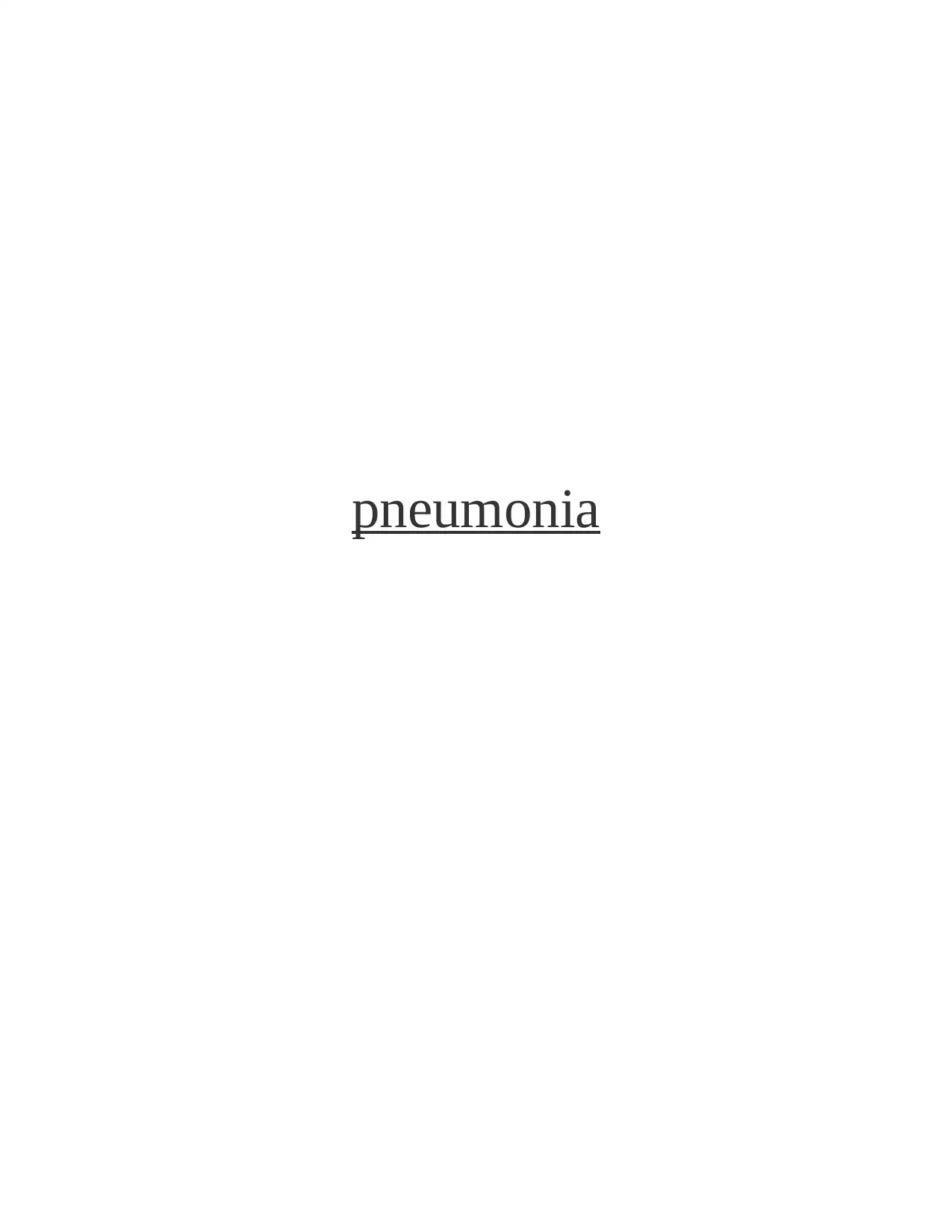
pneumonia
Paraphrase This Document
Need a fresh take? Get an instant paraphrase of this document with our AI Paraphraser
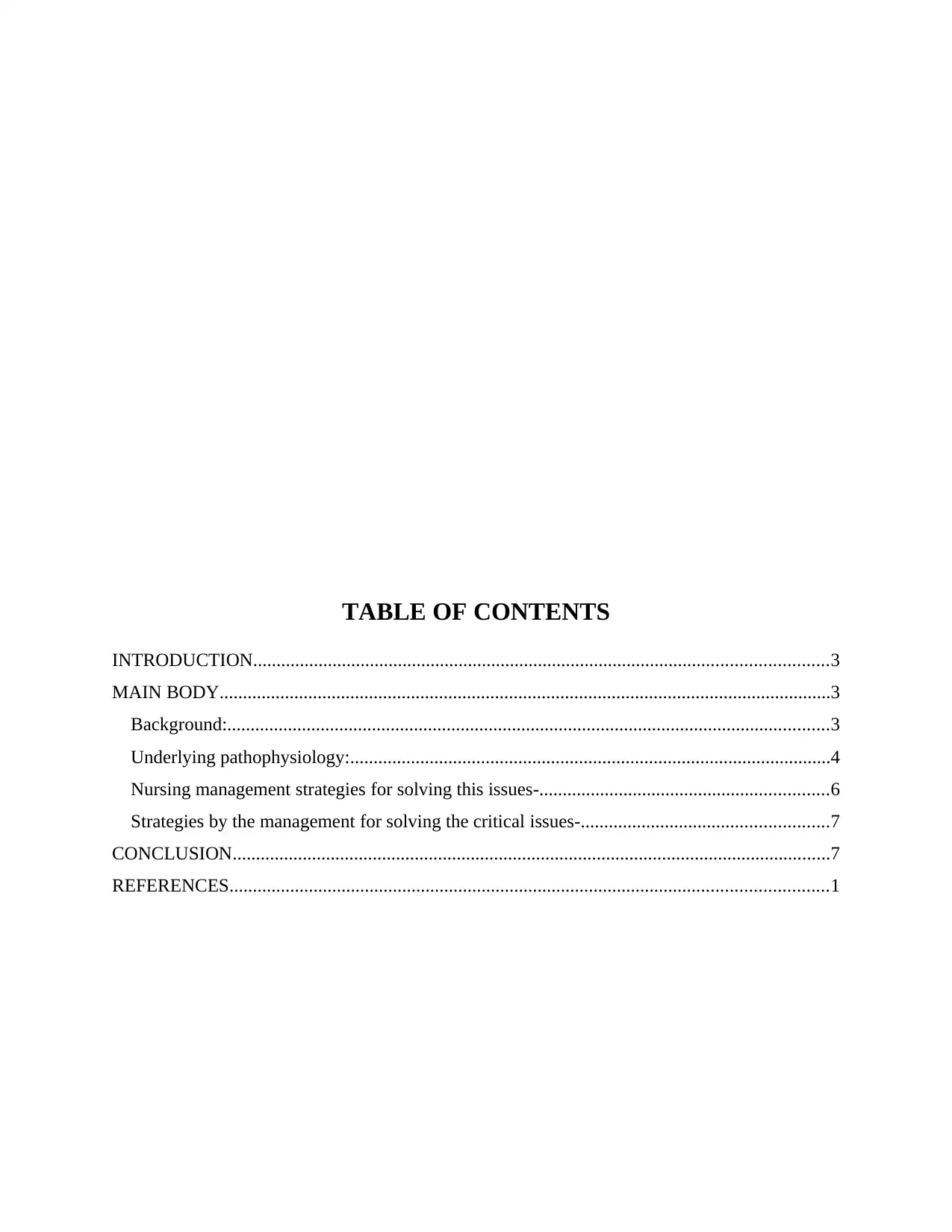
TABLE OF CONTENTS
INTRODUCTION...........................................................................................................................3
MAIN BODY...................................................................................................................................3
Background:.................................................................................................................................3
Underlying pathophysiology:.......................................................................................................4
Nursing management strategies for solving this issues-..............................................................6
Strategies by the management for solving the critical issues-.....................................................7
CONCLUSION................................................................................................................................7
REFERENCES................................................................................................................................1
INTRODUCTION...........................................................................................................................3
MAIN BODY...................................................................................................................................3
Background:.................................................................................................................................3
Underlying pathophysiology:.......................................................................................................4
Nursing management strategies for solving this issues-..............................................................6
Strategies by the management for solving the critical issues-.....................................................7
CONCLUSION................................................................................................................................7
REFERENCES................................................................................................................................1
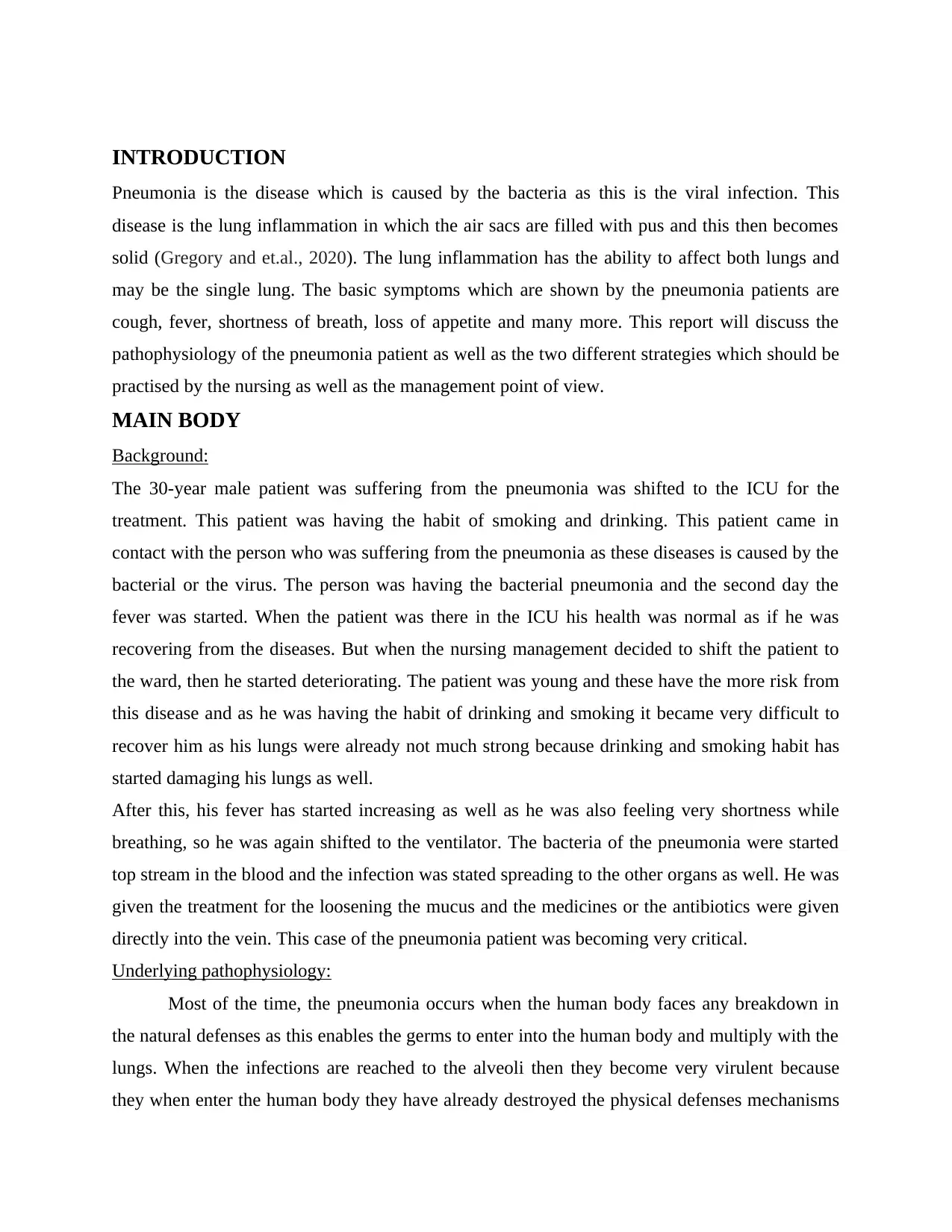
INTRODUCTION
Pneumonia is the disease which is caused by the bacteria as this is the viral infection. This
disease is the lung inflammation in which the air sacs are filled with pus and this then becomes
solid (Gregory and et.al., 2020). The lung inflammation has the ability to affect both lungs and
may be the single lung. The basic symptoms which are shown by the pneumonia patients are
cough, fever, shortness of breath, loss of appetite and many more. This report will discuss the
pathophysiology of the pneumonia patient as well as the two different strategies which should be
practised by the nursing as well as the management point of view.
MAIN BODY
Background:
The 30-year male patient was suffering from the pneumonia was shifted to the ICU for the
treatment. This patient was having the habit of smoking and drinking. This patient came in
contact with the person who was suffering from the pneumonia as these diseases is caused by the
bacterial or the virus. The person was having the bacterial pneumonia and the second day the
fever was started. When the patient was there in the ICU his health was normal as if he was
recovering from the diseases. But when the nursing management decided to shift the patient to
the ward, then he started deteriorating. The patient was young and these have the more risk from
this disease and as he was having the habit of drinking and smoking it became very difficult to
recover him as his lungs were already not much strong because drinking and smoking habit has
started damaging his lungs as well.
After this, his fever has started increasing as well as he was also feeling very shortness while
breathing, so he was again shifted to the ventilator. The bacteria of the pneumonia were started
top stream in the blood and the infection was stated spreading to the other organs as well. He was
given the treatment for the loosening the mucus and the medicines or the antibiotics were given
directly into the vein. This case of the pneumonia patient was becoming very critical.
Underlying pathophysiology:
Most of the time, the pneumonia occurs when the human body faces any breakdown in
the natural defenses as this enables the germs to enter into the human body and multiply with the
lungs. When the infections are reached to the alveoli then they become very virulent because
they when enter the human body they have already destroyed the physical defenses mechanisms
Pneumonia is the disease which is caused by the bacteria as this is the viral infection. This
disease is the lung inflammation in which the air sacs are filled with pus and this then becomes
solid (Gregory and et.al., 2020). The lung inflammation has the ability to affect both lungs and
may be the single lung. The basic symptoms which are shown by the pneumonia patients are
cough, fever, shortness of breath, loss of appetite and many more. This report will discuss the
pathophysiology of the pneumonia patient as well as the two different strategies which should be
practised by the nursing as well as the management point of view.
MAIN BODY
Background:
The 30-year male patient was suffering from the pneumonia was shifted to the ICU for the
treatment. This patient was having the habit of smoking and drinking. This patient came in
contact with the person who was suffering from the pneumonia as these diseases is caused by the
bacterial or the virus. The person was having the bacterial pneumonia and the second day the
fever was started. When the patient was there in the ICU his health was normal as if he was
recovering from the diseases. But when the nursing management decided to shift the patient to
the ward, then he started deteriorating. The patient was young and these have the more risk from
this disease and as he was having the habit of drinking and smoking it became very difficult to
recover him as his lungs were already not much strong because drinking and smoking habit has
started damaging his lungs as well.
After this, his fever has started increasing as well as he was also feeling very shortness while
breathing, so he was again shifted to the ventilator. The bacteria of the pneumonia were started
top stream in the blood and the infection was stated spreading to the other organs as well. He was
given the treatment for the loosening the mucus and the medicines or the antibiotics were given
directly into the vein. This case of the pneumonia patient was becoming very critical.
Underlying pathophysiology:
Most of the time, the pneumonia occurs when the human body faces any breakdown in
the natural defenses as this enables the germs to enter into the human body and multiply with the
lungs. When the infections are reached to the alveoli then they become very virulent because
they when enter the human body they have already destroyed the physical defenses mechanisms
⊘ This is a preview!⊘
Do you want full access?
Subscribe today to unlock all pages.

Trusted by 1+ million students worldwide
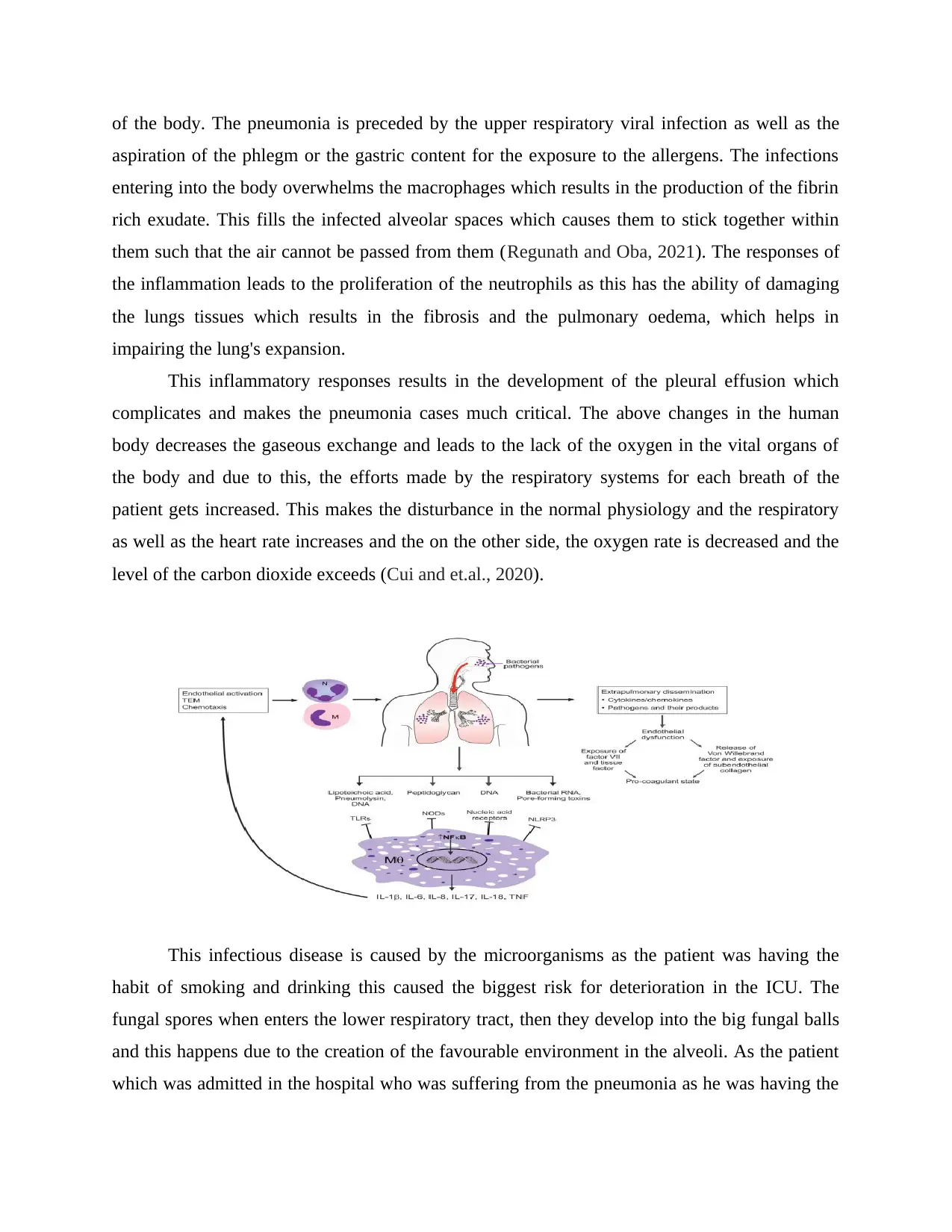
of the body. The pneumonia is preceded by the upper respiratory viral infection as well as the
aspiration of the phlegm or the gastric content for the exposure to the allergens. The infections
entering into the body overwhelms the macrophages which results in the production of the fibrin
rich exudate. This fills the infected alveolar spaces which causes them to stick together within
them such that the air cannot be passed from them (Regunath and Oba, 2021). The responses of
the inflammation leads to the proliferation of the neutrophils as this has the ability of damaging
the lungs tissues which results in the fibrosis and the pulmonary oedema, which helps in
impairing the lung's expansion.
This inflammatory responses results in the development of the pleural effusion which
complicates and makes the pneumonia cases much critical. The above changes in the human
body decreases the gaseous exchange and leads to the lack of the oxygen in the vital organs of
the body and due to this, the efforts made by the respiratory systems for each breath of the
patient gets increased. This makes the disturbance in the normal physiology and the respiratory
as well as the heart rate increases and the on the other side, the oxygen rate is decreased and the
level of the carbon dioxide exceeds (Cui and et.al., 2020).
This infectious disease is caused by the microorganisms as the patient was having the
habit of smoking and drinking this caused the biggest risk for deterioration in the ICU. The
fungal spores when enters the lower respiratory tract, then they develop into the big fungal balls
and this happens due to the creation of the favourable environment in the alveoli. As the patient
which was admitted in the hospital who was suffering from the pneumonia as he was having the
aspiration of the phlegm or the gastric content for the exposure to the allergens. The infections
entering into the body overwhelms the macrophages which results in the production of the fibrin
rich exudate. This fills the infected alveolar spaces which causes them to stick together within
them such that the air cannot be passed from them (Regunath and Oba, 2021). The responses of
the inflammation leads to the proliferation of the neutrophils as this has the ability of damaging
the lungs tissues which results in the fibrosis and the pulmonary oedema, which helps in
impairing the lung's expansion.
This inflammatory responses results in the development of the pleural effusion which
complicates and makes the pneumonia cases much critical. The above changes in the human
body decreases the gaseous exchange and leads to the lack of the oxygen in the vital organs of
the body and due to this, the efforts made by the respiratory systems for each breath of the
patient gets increased. This makes the disturbance in the normal physiology and the respiratory
as well as the heart rate increases and the on the other side, the oxygen rate is decreased and the
level of the carbon dioxide exceeds (Cui and et.al., 2020).
This infectious disease is caused by the microorganisms as the patient was having the
habit of smoking and drinking this caused the biggest risk for deterioration in the ICU. The
fungal spores when enters the lower respiratory tract, then they develop into the big fungal balls
and this happens due to the creation of the favourable environment in the alveoli. As the patient
which was admitted in the hospital who was suffering from the pneumonia as he was having the
Paraphrase This Document
Need a fresh take? Get an instant paraphrase of this document with our AI Paraphraser
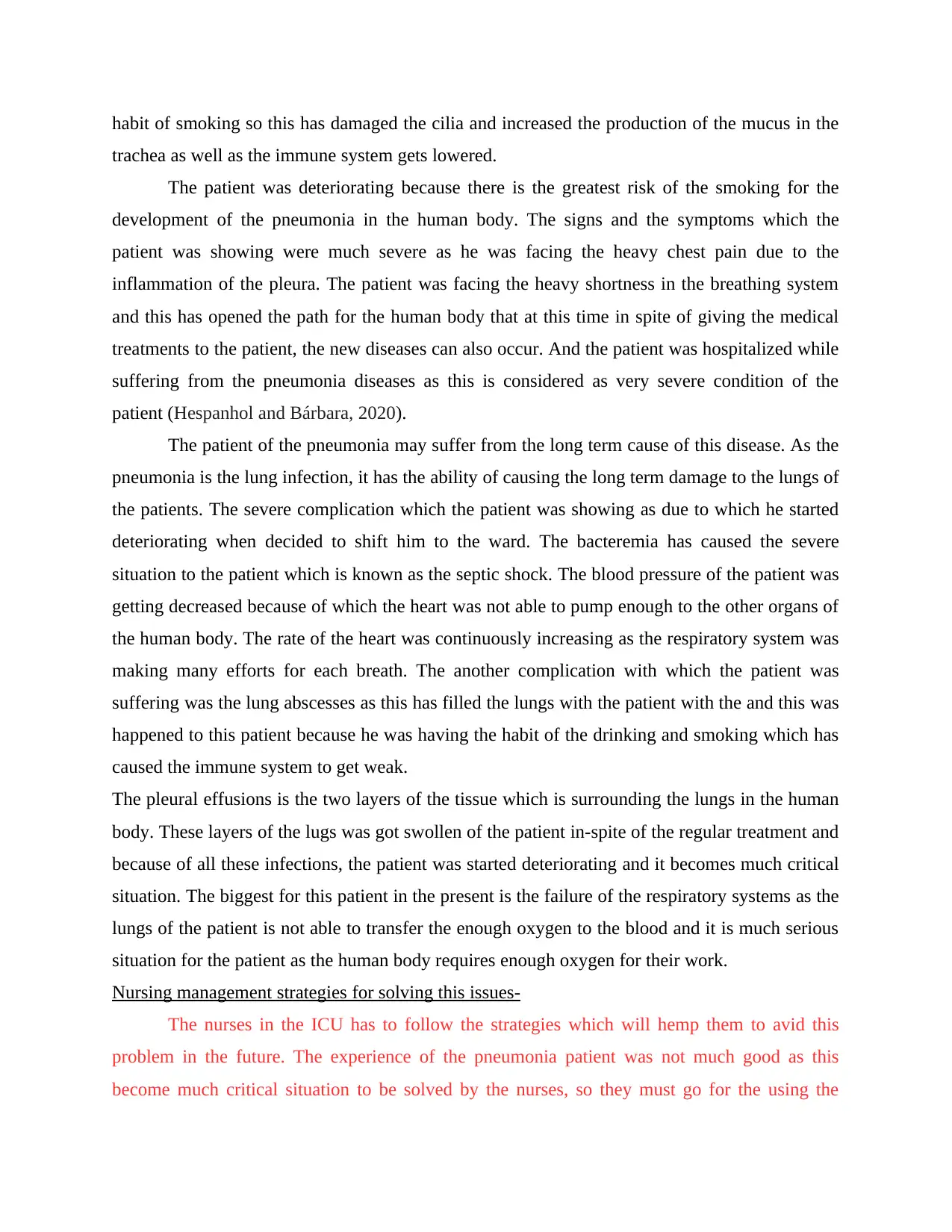
habit of smoking so this has damaged the cilia and increased the production of the mucus in the
trachea as well as the immune system gets lowered.
The patient was deteriorating because there is the greatest risk of the smoking for the
development of the pneumonia in the human body. The signs and the symptoms which the
patient was showing were much severe as he was facing the heavy chest pain due to the
inflammation of the pleura. The patient was facing the heavy shortness in the breathing system
and this has opened the path for the human body that at this time in spite of giving the medical
treatments to the patient, the new diseases can also occur. And the patient was hospitalized while
suffering from the pneumonia diseases as this is considered as very severe condition of the
patient (Hespanhol and Bárbara, 2020).
The patient of the pneumonia may suffer from the long term cause of this disease. As the
pneumonia is the lung infection, it has the ability of causing the long term damage to the lungs of
the patients. The severe complication which the patient was showing as due to which he started
deteriorating when decided to shift him to the ward. The bacteremia has caused the severe
situation to the patient which is known as the septic shock. The blood pressure of the patient was
getting decreased because of which the heart was not able to pump enough to the other organs of
the human body. The rate of the heart was continuously increasing as the respiratory system was
making many efforts for each breath. The another complication with which the patient was
suffering was the lung abscesses as this has filled the lungs with the patient with the and this was
happened to this patient because he was having the habit of the drinking and smoking which has
caused the immune system to get weak.
The pleural effusions is the two layers of the tissue which is surrounding the lungs in the human
body. These layers of the lugs was got swollen of the patient in-spite of the regular treatment and
because of all these infections, the patient was started deteriorating and it becomes much critical
situation. The biggest for this patient in the present is the failure of the respiratory systems as the
lungs of the patient is not able to transfer the enough oxygen to the blood and it is much serious
situation for the patient as the human body requires enough oxygen for their work.
Nursing management strategies for solving this issues-
The nurses in the ICU has to follow the strategies which will hemp them to avid this
problem in the future. The experience of the pneumonia patient was not much good as this
become much critical situation to be solved by the nurses, so they must go for the using the
trachea as well as the immune system gets lowered.
The patient was deteriorating because there is the greatest risk of the smoking for the
development of the pneumonia in the human body. The signs and the symptoms which the
patient was showing were much severe as he was facing the heavy chest pain due to the
inflammation of the pleura. The patient was facing the heavy shortness in the breathing system
and this has opened the path for the human body that at this time in spite of giving the medical
treatments to the patient, the new diseases can also occur. And the patient was hospitalized while
suffering from the pneumonia diseases as this is considered as very severe condition of the
patient (Hespanhol and Bárbara, 2020).
The patient of the pneumonia may suffer from the long term cause of this disease. As the
pneumonia is the lung infection, it has the ability of causing the long term damage to the lungs of
the patients. The severe complication which the patient was showing as due to which he started
deteriorating when decided to shift him to the ward. The bacteremia has caused the severe
situation to the patient which is known as the septic shock. The blood pressure of the patient was
getting decreased because of which the heart was not able to pump enough to the other organs of
the human body. The rate of the heart was continuously increasing as the respiratory system was
making many efforts for each breath. The another complication with which the patient was
suffering was the lung abscesses as this has filled the lungs with the patient with the and this was
happened to this patient because he was having the habit of the drinking and smoking which has
caused the immune system to get weak.
The pleural effusions is the two layers of the tissue which is surrounding the lungs in the human
body. These layers of the lugs was got swollen of the patient in-spite of the regular treatment and
because of all these infections, the patient was started deteriorating and it becomes much critical
situation. The biggest for this patient in the present is the failure of the respiratory systems as the
lungs of the patient is not able to transfer the enough oxygen to the blood and it is much serious
situation for the patient as the human body requires enough oxygen for their work.
Nursing management strategies for solving this issues-
The nurses in the ICU has to follow the strategies which will hemp them to avid this
problem in the future. The experience of the pneumonia patient was not much good as this
become much critical situation to be solved by the nurses, so they must go for the using the
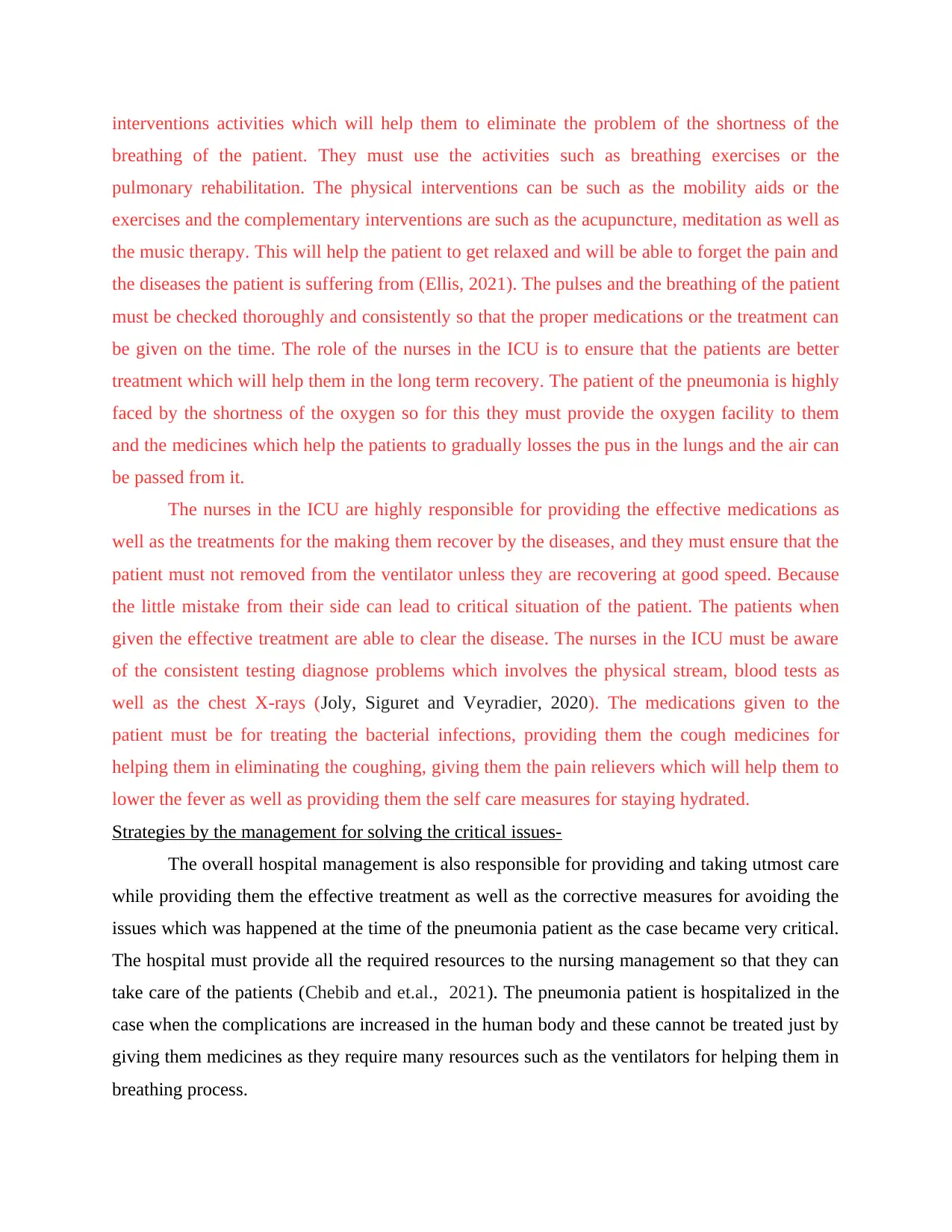
interventions activities which will help them to eliminate the problem of the shortness of the
breathing of the patient. They must use the activities such as breathing exercises or the
pulmonary rehabilitation. The physical interventions can be such as the mobility aids or the
exercises and the complementary interventions are such as the acupuncture, meditation as well as
the music therapy. This will help the patient to get relaxed and will be able to forget the pain and
the diseases the patient is suffering from (Ellis, 2021). The pulses and the breathing of the patient
must be checked thoroughly and consistently so that the proper medications or the treatment can
be given on the time. The role of the nurses in the ICU is to ensure that the patients are better
treatment which will help them in the long term recovery. The patient of the pneumonia is highly
faced by the shortness of the oxygen so for this they must provide the oxygen facility to them
and the medicines which help the patients to gradually losses the pus in the lungs and the air can
be passed from it.
The nurses in the ICU are highly responsible for providing the effective medications as
well as the treatments for the making them recover by the diseases, and they must ensure that the
patient must not removed from the ventilator unless they are recovering at good speed. Because
the little mistake from their side can lead to critical situation of the patient. The patients when
given the effective treatment are able to clear the disease. The nurses in the ICU must be aware
of the consistent testing diagnose problems which involves the physical stream, blood tests as
well as the chest X-rays (Joly, Siguret and Veyradier, 2020). The medications given to the
patient must be for treating the bacterial infections, providing them the cough medicines for
helping them in eliminating the coughing, giving them the pain relievers which will help them to
lower the fever as well as providing them the self care measures for staying hydrated.
Strategies by the management for solving the critical issues-
The overall hospital management is also responsible for providing and taking utmost care
while providing them the effective treatment as well as the corrective measures for avoiding the
issues which was happened at the time of the pneumonia patient as the case became very critical.
The hospital must provide all the required resources to the nursing management so that they can
take care of the patients (Chebib and et.al., 2021). The pneumonia patient is hospitalized in the
case when the complications are increased in the human body and these cannot be treated just by
giving them medicines as they require many resources such as the ventilators for helping them in
breathing process.
breathing of the patient. They must use the activities such as breathing exercises or the
pulmonary rehabilitation. The physical interventions can be such as the mobility aids or the
exercises and the complementary interventions are such as the acupuncture, meditation as well as
the music therapy. This will help the patient to get relaxed and will be able to forget the pain and
the diseases the patient is suffering from (Ellis, 2021). The pulses and the breathing of the patient
must be checked thoroughly and consistently so that the proper medications or the treatment can
be given on the time. The role of the nurses in the ICU is to ensure that the patients are better
treatment which will help them in the long term recovery. The patient of the pneumonia is highly
faced by the shortness of the oxygen so for this they must provide the oxygen facility to them
and the medicines which help the patients to gradually losses the pus in the lungs and the air can
be passed from it.
The nurses in the ICU are highly responsible for providing the effective medications as
well as the treatments for the making them recover by the diseases, and they must ensure that the
patient must not removed from the ventilator unless they are recovering at good speed. Because
the little mistake from their side can lead to critical situation of the patient. The patients when
given the effective treatment are able to clear the disease. The nurses in the ICU must be aware
of the consistent testing diagnose problems which involves the physical stream, blood tests as
well as the chest X-rays (Joly, Siguret and Veyradier, 2020). The medications given to the
patient must be for treating the bacterial infections, providing them the cough medicines for
helping them in eliminating the coughing, giving them the pain relievers which will help them to
lower the fever as well as providing them the self care measures for staying hydrated.
Strategies by the management for solving the critical issues-
The overall hospital management is also responsible for providing and taking utmost care
while providing them the effective treatment as well as the corrective measures for avoiding the
issues which was happened at the time of the pneumonia patient as the case became very critical.
The hospital must provide all the required resources to the nursing management so that they can
take care of the patients (Chebib and et.al., 2021). The pneumonia patient is hospitalized in the
case when the complications are increased in the human body and these cannot be treated just by
giving them medicines as they require many resources such as the ventilators for helping them in
breathing process.
⊘ This is a preview!⊘
Do you want full access?
Subscribe today to unlock all pages.

Trusted by 1+ million students worldwide
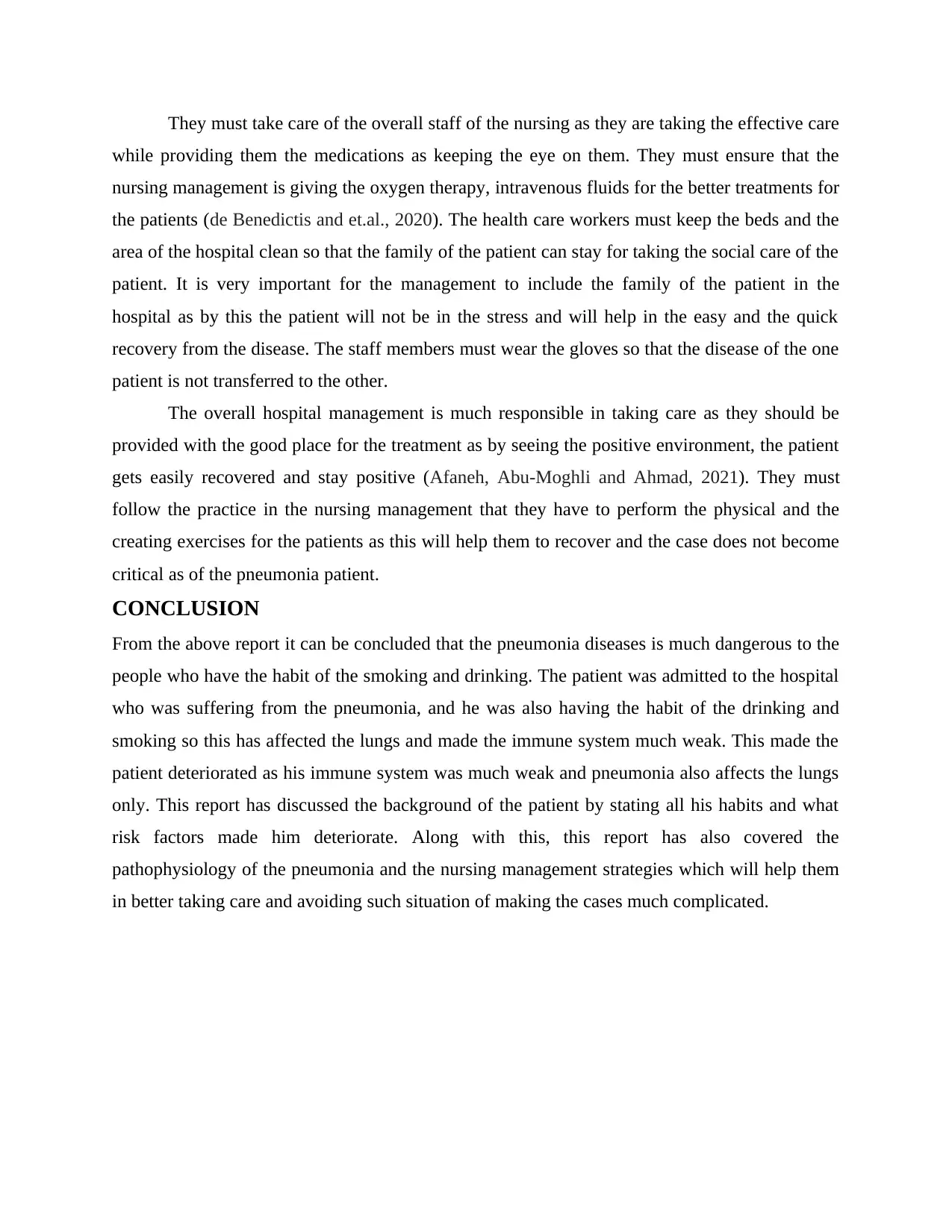
They must take care of the overall staff of the nursing as they are taking the effective care
while providing them the medications as keeping the eye on them. They must ensure that the
nursing management is giving the oxygen therapy, intravenous fluids for the better treatments for
the patients (de Benedictis and et.al., 2020). The health care workers must keep the beds and the
area of the hospital clean so that the family of the patient can stay for taking the social care of the
patient. It is very important for the management to include the family of the patient in the
hospital as by this the patient will not be in the stress and will help in the easy and the quick
recovery from the disease. The staff members must wear the gloves so that the disease of the one
patient is not transferred to the other.
The overall hospital management is much responsible in taking care as they should be
provided with the good place for the treatment as by seeing the positive environment, the patient
gets easily recovered and stay positive (Afaneh, Abu-Moghli and Ahmad, 2021). They must
follow the practice in the nursing management that they have to perform the physical and the
creating exercises for the patients as this will help them to recover and the case does not become
critical as of the pneumonia patient.
CONCLUSION
From the above report it can be concluded that the pneumonia diseases is much dangerous to the
people who have the habit of the smoking and drinking. The patient was admitted to the hospital
who was suffering from the pneumonia, and he was also having the habit of the drinking and
smoking so this has affected the lungs and made the immune system much weak. This made the
patient deteriorated as his immune system was much weak and pneumonia also affects the lungs
only. This report has discussed the background of the patient by stating all his habits and what
risk factors made him deteriorate. Along with this, this report has also covered the
pathophysiology of the pneumonia and the nursing management strategies which will help them
in better taking care and avoiding such situation of making the cases much complicated.
while providing them the medications as keeping the eye on them. They must ensure that the
nursing management is giving the oxygen therapy, intravenous fluids for the better treatments for
the patients (de Benedictis and et.al., 2020). The health care workers must keep the beds and the
area of the hospital clean so that the family of the patient can stay for taking the social care of the
patient. It is very important for the management to include the family of the patient in the
hospital as by this the patient will not be in the stress and will help in the easy and the quick
recovery from the disease. The staff members must wear the gloves so that the disease of the one
patient is not transferred to the other.
The overall hospital management is much responsible in taking care as they should be
provided with the good place for the treatment as by seeing the positive environment, the patient
gets easily recovered and stay positive (Afaneh, Abu-Moghli and Ahmad, 2021). They must
follow the practice in the nursing management that they have to perform the physical and the
creating exercises for the patients as this will help them to recover and the case does not become
critical as of the pneumonia patient.
CONCLUSION
From the above report it can be concluded that the pneumonia diseases is much dangerous to the
people who have the habit of the smoking and drinking. The patient was admitted to the hospital
who was suffering from the pneumonia, and he was also having the habit of the drinking and
smoking so this has affected the lungs and made the immune system much weak. This made the
patient deteriorated as his immune system was much weak and pneumonia also affects the lungs
only. This report has discussed the background of the patient by stating all his habits and what
risk factors made him deteriorate. Along with this, this report has also covered the
pathophysiology of the pneumonia and the nursing management strategies which will help them
in better taking care and avoiding such situation of making the cases much complicated.
Paraphrase This Document
Need a fresh take? Get an instant paraphrase of this document with our AI Paraphraser
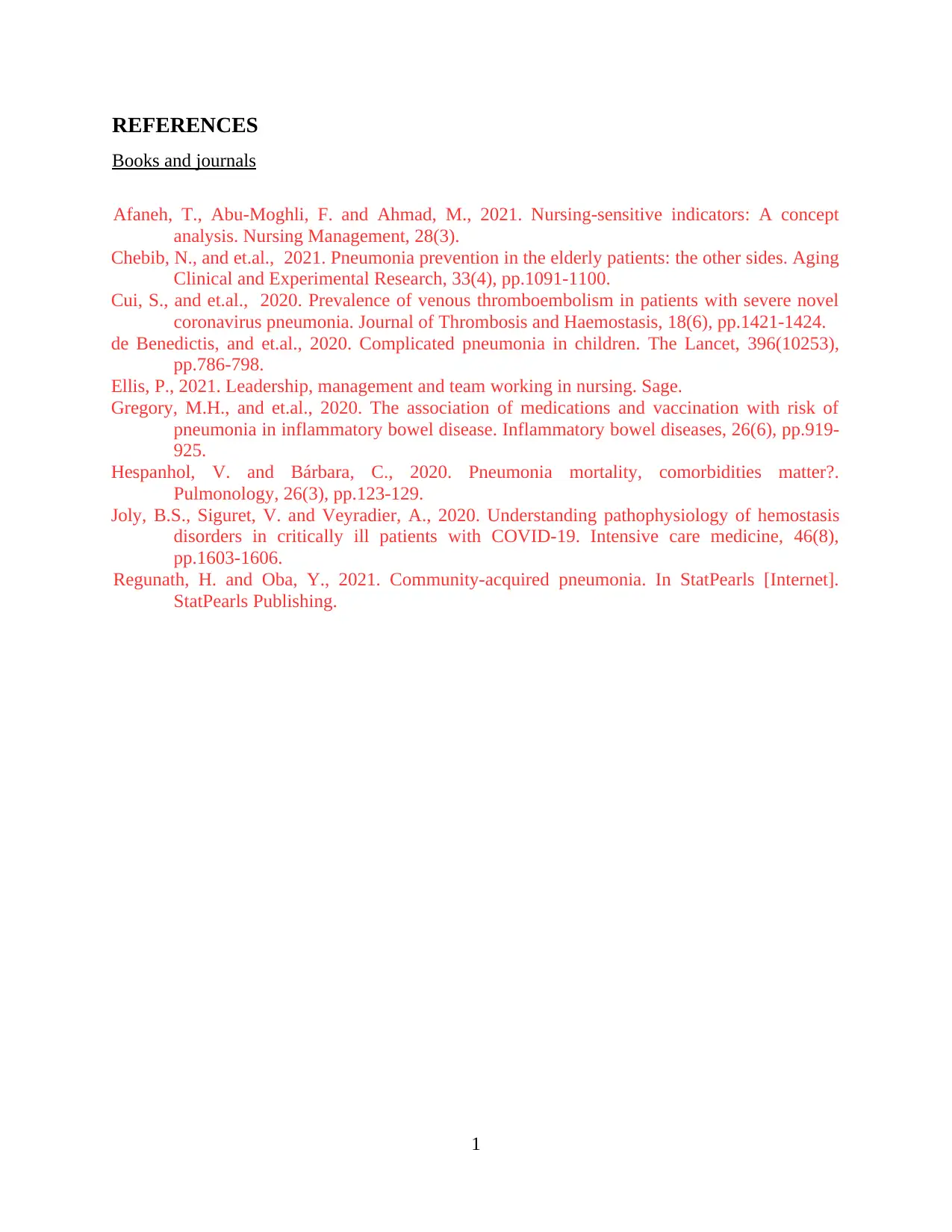
REFERENCES
Books and journals
Afaneh, T., Abu-Moghli, F. and Ahmad, M., 2021. Nursing-sensitive indicators: A concept
analysis. Nursing Management, 28(3).
Chebib, N., and et.al., 2021. Pneumonia prevention in the elderly patients: the other sides. Aging
Clinical and Experimental Research, 33(4), pp.1091-1100.
Cui, S., and et.al., 2020. Prevalence of venous thromboembolism in patients with severe novel
coronavirus pneumonia. Journal of Thrombosis and Haemostasis, 18(6), pp.1421-1424.
de Benedictis, and et.al., 2020. Complicated pneumonia in children. The Lancet, 396(10253),
pp.786-798.
Ellis, P., 2021. Leadership, management and team working in nursing. Sage.
Gregory, M.H., and et.al., 2020. The association of medications and vaccination with risk of
pneumonia in inflammatory bowel disease. Inflammatory bowel diseases, 26(6), pp.919-
925.
Hespanhol, V. and Bárbara, C., 2020. Pneumonia mortality, comorbidities matter?.
Pulmonology, 26(3), pp.123-129.
Joly, B.S., Siguret, V. and Veyradier, A., 2020. Understanding pathophysiology of hemostasis
disorders in critically ill patients with COVID-19. Intensive care medicine, 46(8),
pp.1603-1606.
Regunath, H. and Oba, Y., 2021. Community-acquired pneumonia. In StatPearls [Internet].
StatPearls Publishing.
1
Books and journals
Afaneh, T., Abu-Moghli, F. and Ahmad, M., 2021. Nursing-sensitive indicators: A concept
analysis. Nursing Management, 28(3).
Chebib, N., and et.al., 2021. Pneumonia prevention in the elderly patients: the other sides. Aging
Clinical and Experimental Research, 33(4), pp.1091-1100.
Cui, S., and et.al., 2020. Prevalence of venous thromboembolism in patients with severe novel
coronavirus pneumonia. Journal of Thrombosis and Haemostasis, 18(6), pp.1421-1424.
de Benedictis, and et.al., 2020. Complicated pneumonia in children. The Lancet, 396(10253),
pp.786-798.
Ellis, P., 2021. Leadership, management and team working in nursing. Sage.
Gregory, M.H., and et.al., 2020. The association of medications and vaccination with risk of
pneumonia in inflammatory bowel disease. Inflammatory bowel diseases, 26(6), pp.919-
925.
Hespanhol, V. and Bárbara, C., 2020. Pneumonia mortality, comorbidities matter?.
Pulmonology, 26(3), pp.123-129.
Joly, B.S., Siguret, V. and Veyradier, A., 2020. Understanding pathophysiology of hemostasis
disorders in critically ill patients with COVID-19. Intensive care medicine, 46(8),
pp.1603-1606.
Regunath, H. and Oba, Y., 2021. Community-acquired pneumonia. In StatPearls [Internet].
StatPearls Publishing.
1
1 out of 8
Related Documents
Your All-in-One AI-Powered Toolkit for Academic Success.
+13062052269
info@desklib.com
Available 24*7 on WhatsApp / Email
![[object Object]](/_next/static/media/star-bottom.7253800d.svg)
Unlock your academic potential
Copyright © 2020–2025 A2Z Services. All Rights Reserved. Developed and managed by ZUCOL.





